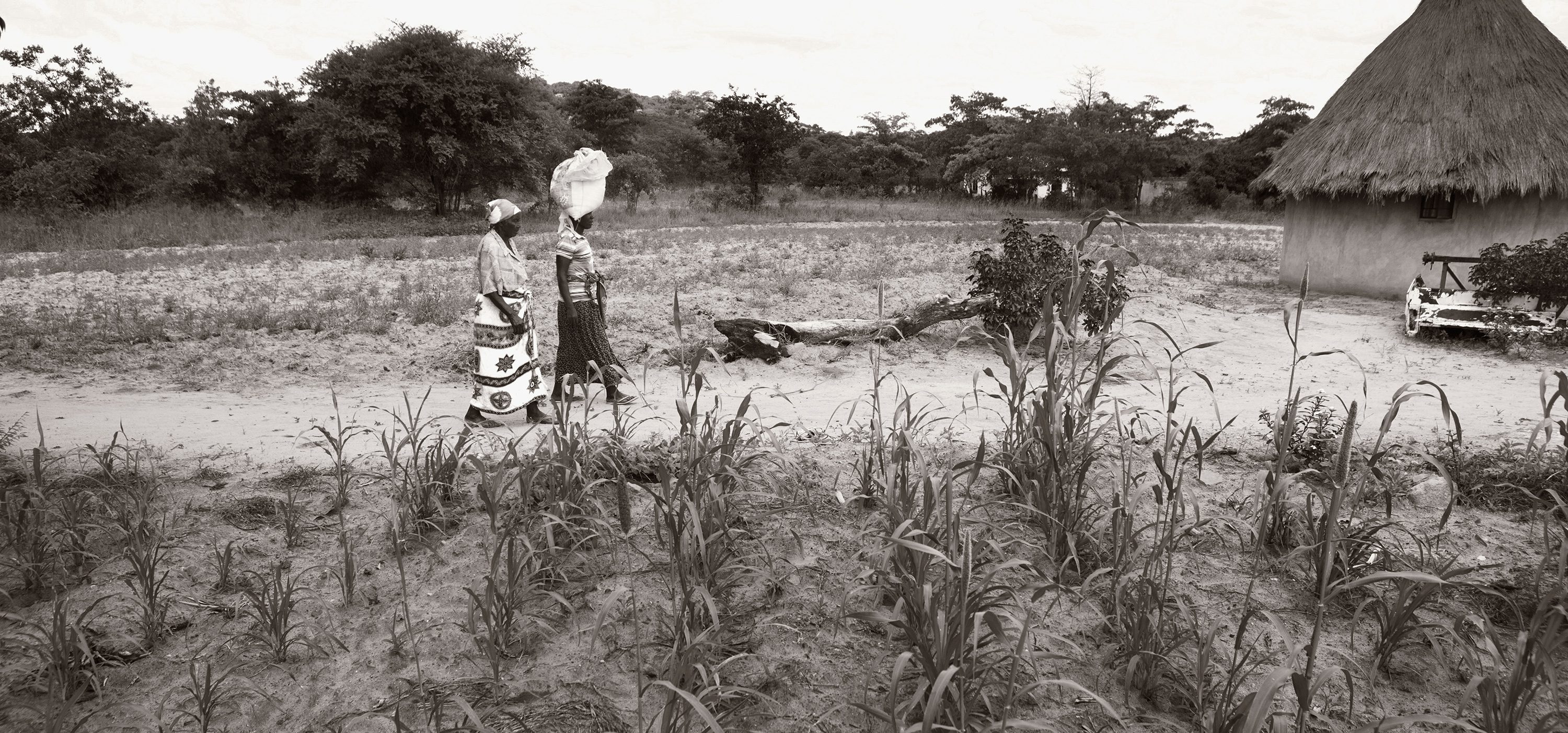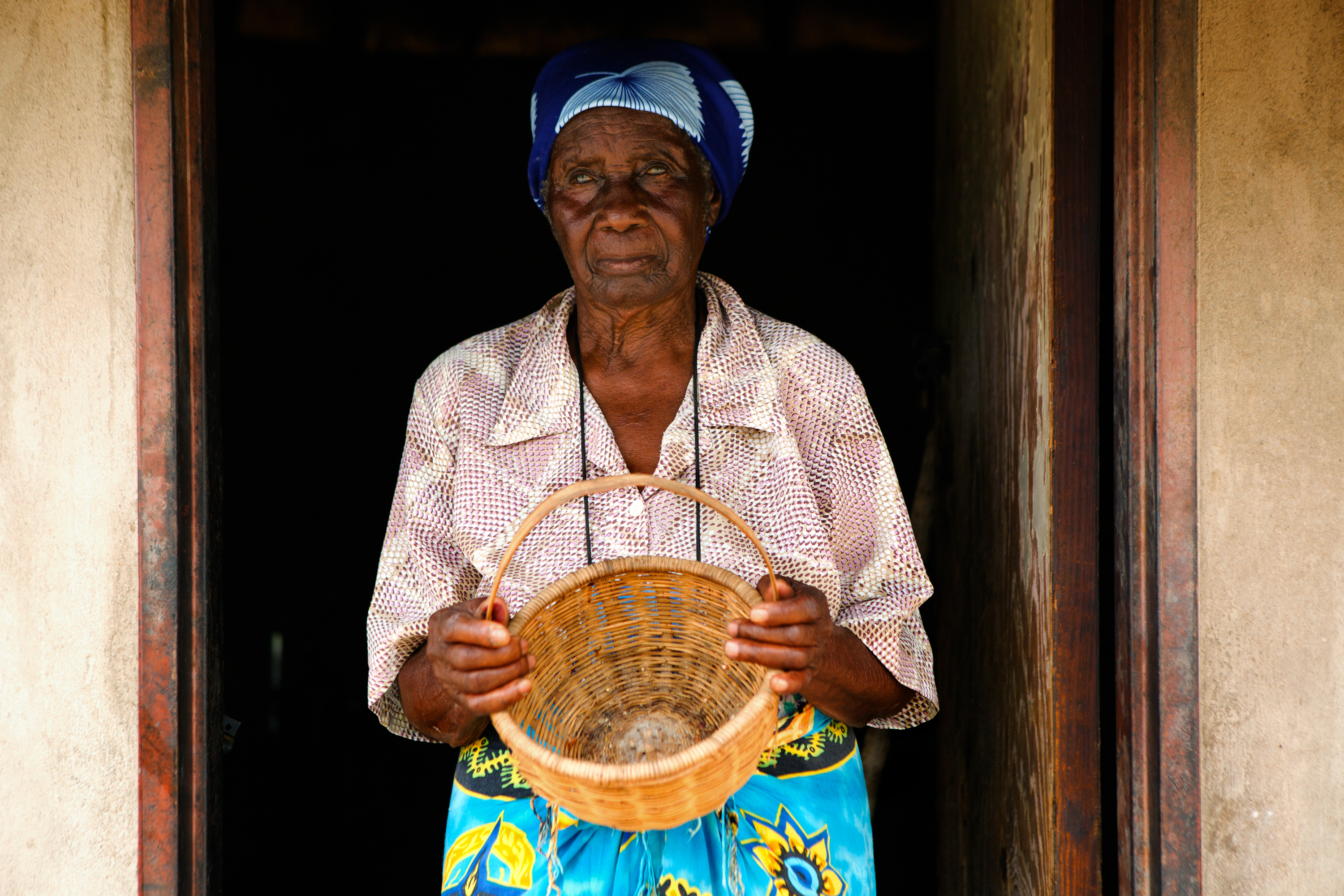Zimbabwe’s climate migration is a sign of what’s to come


Climate change will force tens of millions of people in sub-Saharan Africa to migrate by 2050. In Zimbabwe, it's already started.

AP PHOTO/TSVANGIRAYI MUKWAZHI
by
December 17, 2021
Julius Mutero has harvested virtually nothing in the past six years. For his entire adult life, he has farmed a three-hectare plot in Mabiya, a farming community in eastern Zimbabwe. There he grows maize and groundnuts to feed himself, his wife, and their three children. He sells whatever’s left for cash.
But over a decade ago, his area started getting less rain and the rivers dried up. What was already a hot climate, with temperatures that could reach 30 °C (86 °F), began recording summer highs up to 37 °C (99 °F) on a regular basis. Now the rainy season begins in late December instead of early November, and it ends sooner too. In the driest months, dust billows across sunbaked farmlands where only thorny shrubs remain.
Years of severe droughts have wiped out all Mutero’s crops. He tried planting maize varieties that mature early, but even they didn’t survive. And with no pastures for his livestock, he watched helplessly as all seven of his cows died.
“Life is now extremely hard here,” Mutero says. His family survives largely on food aid supplied by nonprofits or Zimbabwe’s government, but it’s not enough.
He feels he has no choice but to abandon his home in search of water. He’s fortunate—a traditional leader has promised him a small piece of land about 30 kilometers from Mabiya in the country’s Eastern Highlands, which get more rain and heavier mists than the rest of the country.
Advertisement
When we spoke in October, Mutero was planning to build a new home and relocate his family by year’s end. But he was nervous. “I don’t know what my family and I will face and how we will be received,” he said.
Mutero is just one of the 86 million people in sub-Saharan Africa who the World Bank estimates will migrate domestically by 2050 because of climate change—the largest number predicted in any of six major regions the organization studied for a new report.
In Zimbabwe, farmers who have tried to stay put and adapt by harvesting rainwater or changing what they grow have found their efforts woefully inadequate in the face of new weather extremes. Droughts have already forced tens of thousands from the country’s lowlands to the Eastern Highlands. But their desperate moves are creating new competition for water in the region, and tensions may soon boil over.
Running out
Zimbabwe has endured droughts for the past three decades. But they’re happening more often and becoming more severe as a result of climate change. Up to 70% of people in Zimbabwe make a living from agriculture or related rural economic activities, and millions of subsistence farmers there depend entirely on rain to water their crops. Over the last 40 years, average temperatures have risen by 1 °C , while annual rainfall has decreased by 20 to 30%.
At the height of the most recent drought, which lasted from 2018 to 2020, only about half as much rain fell in Zimbabwe as usual. Crops were scorched and pastures dried up. People and livestock crowded around hand-pumped boreholes to find water, but the wells soon went dry. Some people in the driest areas had so little to eat they survived on the leaves and white, powdery fruit of baobab trees.
More rain fell during the last growing season, but many farmers still feel uneasy about the future. Maize—Zimbabwe’s staple crop, which was aggressively promoted by the former colonial government beginning in the 1940s—is becoming impossible to grow.
Over 5 million Zimbabweans—a third of the population—don’t have enough to eat, according to the World Food Program. A study in 2019 of how vulnerable countries were to agricultural disruption due to drought ranked Zimbabwe third, behind only Botswana and Namibia.
As Mutero and other climate migrants know, conditions are somewhat better in the Eastern Highlands. This mountainous region stretches for around 300 kilometers along Zimbabwe’s border with Mozambique. Many of the region’s major rivers, including the Pungwe and Odzi, begin there as streams. The area’s climate and fertile soils are perfect for growing crops such as tea, coffee, plums, avocados, and a sweet pinkish-red fruit called lychee.
When climate migrants started showing up in the Eastern Highlands a decade ago, they settled without permission on state land, and the government was swift to evict them. But they returned in even larger numbers, and officials have more or less given up trying to stop them.
AdvertisementBy 2015, the government estimated that more than 20,000 migrants had settled in the Eastern Highlands. Though no more recent official estimates exist, anecdotal evidence suggests the number has continued to climb.
Today in some parts of the highlands, migrants occupy any vacant land they can find. In others, traditional or community leaders like the one helping Mutero, who are known in local dialect as sabhuku, have taken up the task of allocating land to migrants. The leaders—whose roles are largely ceremonial—are doing this in defiance of government orders. They’ve earned praise from migrants but disdain from local farmers who were there first.
Two senior government officials in the Eastern Highlands’ Manicaland province—Edgars Seenza, the provincial coordinator, and Charles Kadzere, the provincial lands officer—declined to comment for this story. Vangelis Haritatos, Zimbabwe’s deputy minister for lands, agriculture, fisheries, water, and rural resettlement, didn’t respond to questions sent to his WhatsApp number.
“Soon people will fight”
Leonard Madanhire, a farmer who lives in what’s known as the Mpudzi area in the Eastern Highlands, is worried. He grows mostly maize on his five hectares of land. His herd of cattle has dwindled from more than 20 a decade ago to five. Most nearby grazing lands, which he has long shared with other farmers, are now occupied by climate migrants.
In September, Madanhire took me on a long hike along the banks of the Chitora River. Freshly built dwellings stood on land that was once pasture; other structures dotted the river’s banks. A couple of seemingly frustrated herdsmen were trying to steer cattle and goats through the narrow patches of pasture that remained.
A few kilometers upriver, migrants had planted vegetable gardens on the river’s edges. Madanhire says farming along the banks that way causes erosion and puts more silt and debris in the water for everyone downstream.
“Soon people will fight for the little water left,” he says. Already, skirmishes have broken out between farmers, migrants, and traditional leaders over who settles where and who gets to decide.
Madanhire isn’t alone in his concerns. Josphat Manzini is a banana farmer in Burma Valley, a lucrative farming area in the Eastern Highlands that’s long been renowned for producing the best bananas in the country. He’s been anxious as climate migrants settle on nearby riverbanks and tap the water he needs to irrigate his more than 20 hectares.
Manzini says migrants have overrun several local rivers, taxing water supplies and stirring up so much silt that the debris is obstructing three dams as well as many smaller streams in the area.
Now, for the first time in his life, the prospects for banana farming in the Eastern Highlands are looking bleak. “There is no future here,” Manzini says.
Too little, too late
In scorched parts of Zimbabwe, some farmers have tried to cope and stay put. They’ve returned to planting drought-resistant traditional grains like finger millet, pearl millet, and sorghum. Others have switched from irrigating their crops by flooding entire fields to using systems that drip only the necessary amount of water right next to each plant.
And some, including Blessing Zimunya, a farmer in Chitora, have tried to harvest rainwater for irrigation and other uses. Zimunya uses a 5,000-liter container to collect water from his roof and a 100,000-liter tank to collect runoff on the ground. He supplements these systems with water from a nearby river.
Natalie Watson, the managing director of Bopoma Villages, a nongovernmental organization that runs a clean water and hygiene project, says rainwater harvesting has great potential to make a difference. She cites a well-known Zimbabwean farmer named Zephaniah Phiri Maseko, who before he died transformed dry land into lush fields using methods that Watson’s organization now teaches.
Her program is currently focused on the Zaka district in southern Zimbabwe, where hundreds of farmers are taking part. Some in the nearby province of Midlands have also begun to experiment with rainwater harvesting.
AP PHOTO/TSVANGIRAYI MUKWAZHI

The total number of farmers in Zimbabwe who have taken up the practice is still very low, though. Of the more than 7 million small farmers across the country, only a few thousand in the driest provinces have tried it. Despite the efforts of organizations like Watson’s, most farmers don’t have the money to build large tanks to store water. Many more still don’t know what rainwater harvesting is, or how to get started.
Other nonprofit programs are underway to help farmers adapt by learning new practices to preserve soil moisture and finding ways to diversify their incomes beyond agriculture. And last year, Zimbabwe’s government announced a plan to create 760,000 new “green” jobs in four years in fields like solar, hydropower, energy efficiency, and sustainable agriculture. But these efforts are still in their infancy.
Gift Sanyanga of Haarlem Mutare City Link—a twin-city arrangement between the city of Haarlem in the Netherlands and Zimbabwe’s Mutare that commissioned a 2019 report on climate migration in the Eastern Highlands (and paid for me to travel to Haarlem to speak that same year)—says adaptation measures have largely failed, and the only practical option left for many farmers is to migrate.
Advertisement
Anna Brazier, an independent climate researcher, thinks it’s time for Zimbabwe’s government to actively encourage people to move out of dry areas before conditions get even worse.
“As climate change intensifies, it is going to make some of these areas uninhabitable,” she says. “Rather than having to deal with a rushed mass migration, which will put severe pressure on the areas that people migrate to, we should be planning for a gradual evacuation of the most vulnerable areas now.”
She says the government should do a nationwide land audit to figure out where space is available for migrants and create a process by which people can legally resettle there—perhaps with a bit of money or other support to get them started. While the government is doing a lot to properly relocate people from flood-prone areas, it’s doing little to relocate farmers from places prone to drought.
For many, though, it’s already too late.
Despite the uncertainties that await him in the Eastern Highlands, Mutero has already made up his mind. “I’m moving; nothing will stop me,” he told me. “That’s my only option.”
Andrew Mambondiyani is a science journalist based in Zimbabwe and a former MIT Knight Science Journalism Fellow.
Source
Language of the news reported
Related content:
Copyright © Source (mentioned above). All rights reserved. The Land Portal distributes materials without the copyright owner’s permission based on the “fair use” doctrine of copyright, meaning that we post news articles for non-commercial, informative purposes. If you are the owner of the article or report and would like it to be removed, please contact us at hello@landportal.info and we will remove the posting immediately.
Various news items related to land governance are posted on the Land Portal every day by the Land Portal users, from various sources, such as news organizations and other institutions and individuals, representing a diversity of positions on every topic. The copyright lies with the source of the article; the Land Portal Foundation does not have the legal right to edit or correct the article, nor does the Foundation endorse its content. To make corrections or ask for permission to republish or other authorized use of this material, please contact the copyright holder.
